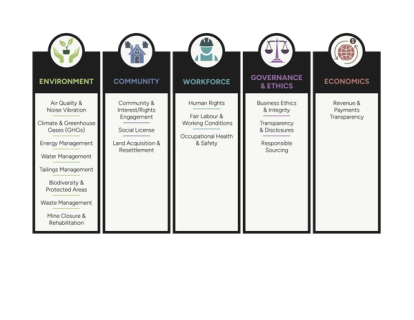
Future Assured Insights: Evaluating the ESG Performance of Canadian Mining Projects
- Post Date
- 20 June 2024
- Read Time
- 8 minutes

Environmental, social, and governance (ESG) imperatives are continuing to shape the future of the mining and minerals sector. Interest and rights holders are becoming increasingly sophisticated in their knowledge, understanding, and expectations regarding the ESG performance of Canadian mining companies. Consumers and end users of manufactured products now scrutinize the origins of the raw materials contained in these products and their respective carbon footprints. As such, assurance that metals and minerals are sourced in environmentally, socially, and fiscally responsible ways has become a business imperative.
“ESG” refers to a collective of business relevant factors relating to an organization's relationship with the natural and human environments. These factors, traditionally under-represented or not adequately contemplated, present significant risks and opportunities for organizations and their advisors.
Now more than ever before, Canadian mining companies need to be “Future Assured”— relevant, positioned, and prepared for the evolving complexities of sustainable development. But how exactly do these companies go about this?
How can Canadian mining companies provide assurance to their interest and other rights holders that their metals and minerals are sourced in an environmentally responsible and ethical manner?
The Canadian mining sector is no stranger to performance audits and standardized public disclosure, both of which play important roles in maintaining transparency and accountability within the industry. Canadian securities regulators require that any public disclosure of scientific and technical information regarding mineral projects must comply with National Instrument 43-101 (NI 43-101). This standard applies to information intended to be, or reasonably likely to be, made available to the investing public.
In addition to NI 43-101, there is a plethora of ESG standards and frameworks applicable to the mining sector—both in Canada and globally—including, but not limited to, Towards Sustainable Mining (TSM), The Copper Mark, The Initiative for Responsible Mining Assurance (IRMA), the International Council on Mining & Metals (ICMM), and the World Gold Council’s Responsible Gold Mining Principles (RGMPs). Many Canadian mining companies, especially junior mining companies, are overwhelmed by the number of ESG standards and frameworks and are often uncertain of what they should be focusing on. Further, existing standards and frameworks are largely focused on the performance of operational sites, not sites in development or pre-operational. So, what about those new mining projects, the ones in early stages of development?
How can we ensure that ESG performance is considered, evaluated, and documented, as early as possible for Canadian metal/mineral mining projects?
How can we help Canadian mining become "Future Assured"?
To better help Canadian mining companies become “Future Assured”, SLR’s Mining Advisory and ESG Advisory teams in Canada are developing a dedicated tool for evaluating the ESG performance of both Canadian metal/mineral mining projects and operational mines without the burden of a traditional “audit” component. This tool will help companies evaluate their current state and provide a roadmap of how to get to the desired state – a step-by-step tool outlining KPIs that need to be achieved to get from point A to B. This is a way to take a project from meeting the minimum standards required to exceeding standards.
The tool—currently called the “ESG Evaluation & Guidance Tool”—is intended to be the first step in visualizing how we could carry out an evaluation of the ESG performance of Canadian metal/mineral mining projects or mines. SLR’s end goal is to take the Workbook and develop it into a more sophisticated tool with data visualization capabilities.
What is the "ESG Evaluation & Guidance Tool"?
The Tool can be used for mine development projects, including those in the earliest stages of development, as well as for established operating sites. The Tool is applied at the project/site level, although it does consider, policies and commitments made at the corporate level.
The ESG Evaluation & Guidance Tool is comprised of five overarching categories: Environment, Community, Workforce, Governance and Ethics, and Economics. Each category consists of a series of KPIs (indicators), informed by guidance published by TSM, The Copper Mark, and IRMA, that together provide a holistic overview of what the Canadian mining sector accepts as current “best practice”.

This Tool differs from current mining ESG standards and frameworks as it intends to evaluate the “current state” of the target project/site—that is, how does the project/site currently score with respect to each indicator—as well as the “desired state” of the target project/site, meaning where it would like to score and what commitments the project/site intends to make (and follow through on) to achieve the desired score. As such, The Tool can also be thought of as a “roadmap” of sorts to help companies identify a project or site’s starting point versus its end point, and what is needed to successfully get from one to the other.
How does the ESG Evaluation & Guidance Tool evaluate ESG performance?
The Tool evaluates indicator performance using a scoring system that was developed largely based on the TSM scoring system. The project/site being evaluated must meet all requirements for one level before moving on to the next level. Each indicator in each category is scored individually, so there is no aggregate scoring allowed. This is to prevent higher-scored indicators from downplaying lower-scored indicators, and vice versa.
The Tool scoring system is comprised of five levels (in order of lowest to highest): Level C, Level B, Level A, Level AA, and Level AAA. A score of Level C—the lowest level—simply indicates that the project/site has not met all Level B criteria. A score of Level AAA—the highest level and the “gold standard”—indicates that the project/site has met all requirements, at all levels, for a specific indicator.

The Tool can be used in two ways: self-evaluation and independent (third-party) evaluation. A mining company can use this Tool to conduct a self-evaluation of its ESG performance for a specific project or site. This can be used to gain insight, inform decision-making and strategic planning, and for continuous improvement. Following completion of its self-evaluation, the mining company can—if it chooses—contact SLR to review and verify its self-evaluation. Alternatively, a mining company can contact SLR to conduct an independent evaluation of the project/site against the indicators in the Tool, which will rely on information and documentation provided to SLR by the mining company. An independent evaluation will require minimal effort from the mining company.
Why should Canadian mining companies use the ESG Evaluation & Guidance Tool?
There are several reasons why Canadian mining companies should consider using the ESG Evaluation & Guidance Tool:
- Reporting is already required, so why not take it one step further? Canadian mining companies are already subject to performance audits and standardized public disclosure, so why not go one step further and use the ESG Evaluation & Guidance Tool and its KPIs to provide a more holistic snapshot of the project or site’s ESG performance? Doing so will demonstrate a strong commitment to environmentally responsible and ethical business practices and transparent communication, which will ultimately help to build trust with interest and other rights holders, including consumers and end users of manufactured products.
- It encourages strategic planning and continuous improvement. The ESG Evaluation & Guidance Tool can be used as an excellent strategic planning tool for development projects as well as to encourage continuous improvement for operational sites. Evaluating and documenting a project or site’s “current state” versus its “desired state” encourages performance transparency, holds a company accountable to its commitments, and provides a clear roadmap of the steps that need to be taken for a project or site to successfully achieve its desired state.
- It allows for easy transition to existing ESG standards and frameworks once the site is operational. Evaluating and documenting the ESG performance of a development project as early as possible will allow for easy transition to existing, more robust ESG standards and frameworks (such as TSM and ICMM) once the mine site is operational.
Stay tuned for more information on the ESG Evaluation & Guidance Tool in the coming months. SLR is Making Sustainability Happen – don’t hesitate to get started on planning and tracking ESG standards today.
Relying on our collective knowledge and expertise, SLR has the capabilities to support Canadian mining companies during all stages of their ESG journeys. From building the foundation of your ESG strategy and identifying key ESG risks and opportunities, to developing and implementing the programs and systems required to manage and monitor those risks and opportunities, to reporting on your ESG performance, SLR is a trusted partner that can provide relevant, fact-based evaluations and develop actionable advice to support your continued ESG strategy development efforts.
Recent posts
-

-

Industrial noise compliance in Alberta: Understanding Directive 038 and Rule 012
by Arthur Kupper
View post -
